


By
Peter Lex
Adendorf, Germany
&
Johann G. Goldammer
Global Fire Monitoring Center
(GFMC)
Introduction
In Germany the main fire problem areas are located in the northern portion of the country where predominantly poor soils are associated with continental climate features. The forests in this region between Lower Saxony in the West and Brandenburg in the East (bordering Poland) are dominated by pine (Pinus sylvestris) stands characterised by a relatively high fire hazard.
The Statistical Database on Forest Fires
In 1991, the first uniform forest fire statistics were introduced in the Federal Republic of Germany. Between the end of the Second World War and the unification of the two separate German republics each system operated its own statistical database (Figure 4-11). The compilation of forest fire statistics of the former German Democratic Republic (GDR – East Germany) started in 1946. Data for the Federal Republic of Germany (West Germany) were
not available before 1957. With the reunification in October 1990, a common fire statistics system was introduced in Germany that met the standards of the ECE/FAO.

Figure 4-11 Average number of forest fires and area burned in Germany in 5- and 10-year periods, 1946-1999.
The majority of fire damages occurred after the war in the East German territory. Although the number of fires was sometimes smaller than in West Germany, the burned area, except from 1971 to 1980, was larger than in West Germany (Figure 4-12). Between 1951 and 1960 the highest post-war fire damage occurred in the GDR (Figure 4-13). In this period the average number of 1 761 fires per year was registered with an average burned area of 3 660 hectares per year. In this context, it is important to note that forest land comprises only 28 percent of East Germany.
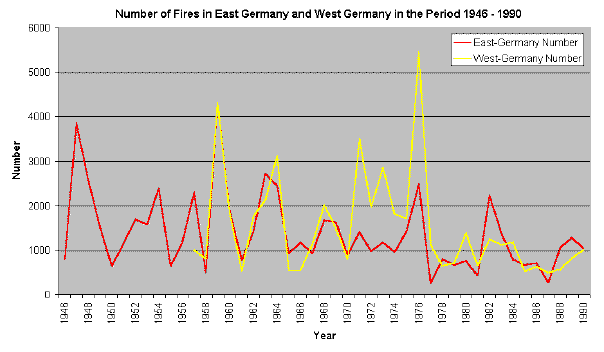
Figure 4-12 Number of forest fires in Germany, 1946-1999.
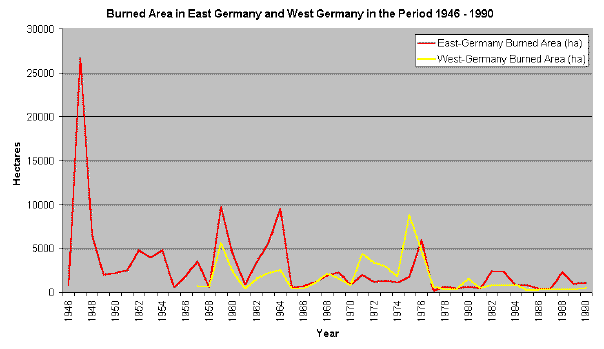
Figure 4-13 Area burned in Germany, 1946-1999.
In 1990, the real causes of fires in the GDR were published for the first time (Missbach 1990). For political reasons the issue was treated secretly. During the period 1951 to 1970 fires caused by negligence mounted 46 percent and, in the subsequent years, up to 60 percent. Railway traffic caused 28 percent of the ignitions by sparks from locomotives which were driven with brown coal. During the period from 1971 to 1988 the percentage of fires caused by military training and exercises increased to 29 percent. These fires were located outside the borders of the military exercise areas; they had been hidden in the statistics before 1990.
In West Germany, the conflagrations of the years 1975 and 1976 in Lower Saxony had a strong impact on the statistics for the period 1971 to 1980. The average number of fires rose to 2 107 with an average burned area of 2 884 ha per year. In 1975 the average size of the burned area per fire increased to 5.15 ha. The number of fires and the area burned depend on inter-annual climate variability and ranged from 242 ha in the wet year 1985 to a maximum of 8 768 ha in the hot and dry year 1975. Therefore, the West German statistical figures show that the burned area of 1975 was 36 times larger than in 1985. The importance of the climate is also represented in the average size of the burned area. In East Germany the amounts ranged from 0.52 up to 6.93 ha between 1946 and 1990; whereas West German data show areas from 0.35 to 5.15 ha (Figure 4-14).
The average burned area per fire in the period 1977 to 1999 is shown in Figure 4-15. After reunification 1992 shows a peak of burned area with 4 908 ha (Figure 4-16). More than 80 percent of these fires happened in East Germany and a considerable number started on military training areas. This phenomenon can be explained by the political circumstances. In the former GDR the fire brigades were managed by fire bosses who were members of the police force. As a result of the reunification they had quit their jobs. The democratically elected new fire bosses lacked the experience in fighting large forest fires. The inadequate technical equipment of the rural voluntary fire brigades worsened the situation.
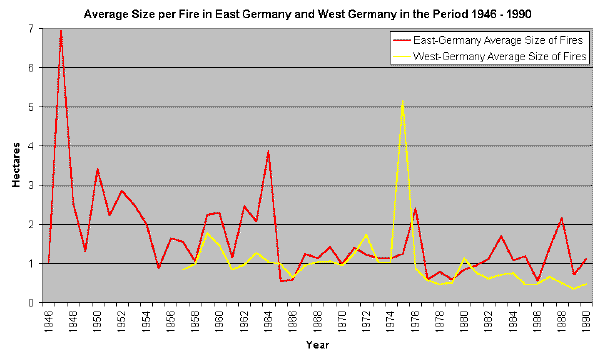
Figure 4-14 Average size per forest fire in Germany, 1946-1999.

Figure 4-15 Average size per forest fire in Germany, 1977-1999.
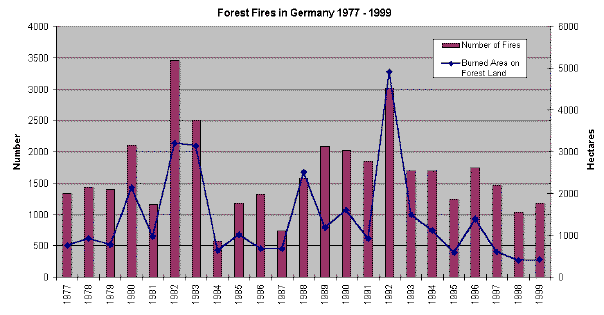
Figure 4-16 Number of forest fires and area burned in Germany, 1977-1999.
Fire causes
Only two percent of all fires are caused by lightning. The identification of fire causes is unsatisfactory because the average percentage of unknown causes is 39 percent from 1991 to 1999 (Figure 4-17, Figure 4-18). Negligence holds second place with 25 percent in the period 1991–1999. Negligence had a higher percentage in West Germany, decreasing from 50 percent to 30 percent between 1961 to 1990. There is a steady increase of arson in West Germany since 1961, with an average percentage of 22 percent in the period 1991–1999 in the whole of reunified Germany. The reduction of military training and the electrification of railways, especially in East Germany, explain the decrease of the “other causes” to ten percent. The four most important “other causes” are the railway, public ways, agriculture and forestry. Figure 4-19 and Figure 4-20 show the monthly distribution of fires between 1995 and 1999 in Germany. The average number and the average burned area in this period indicates two peaks in April and August. This supports the earlier theses of Geiger (1948), Weck (1950), and Missbach (1982) that most fires occur in spring and in high summer.
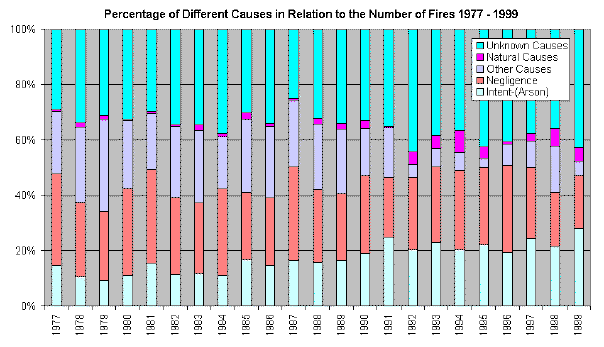
Figure 4-17 Causes of fire in relation the number of fires in Germany, 1977-1999
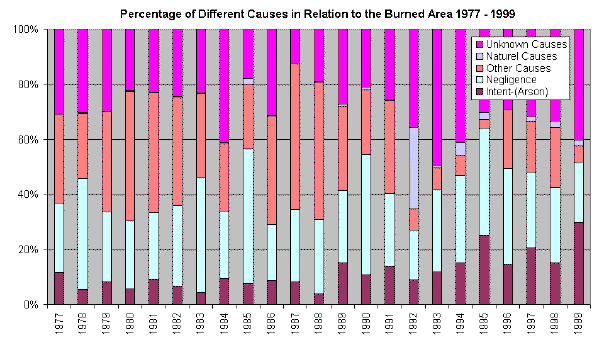
Figure 4-18 Causes of fire in relation the area burned in Germany, 1977-1999.

Figure 4-19 Distribution of number of fires by month in Germany, 1995-1999.
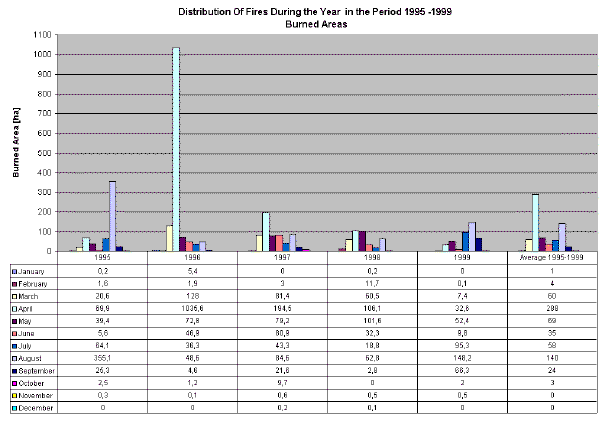
Figure 4-20 Distribution of area burned by month in Germany, 1995-1999.
Prescribed burning
Since forest fire management in Germany is not faced with exceptional fire, problems the use of prescribed fire in forest stands for wildfire hazard reduction has not been seriously considered. Prescribed fire has been proposed and tested in pilot experiments during the 1970s (Goldammer 1979).
However, changing paradigms regarding the role of fire in nature conservation have been observed the past few years. At present new initiatives are demanding the restoration of fire as a dynamic and vital element to maintain biodiversity and the cultural and ecological characteristics of landscapes. Changes in many vegetation types have occurred as a consequence of abandoned traditional land-use practices. Ecologically important disturbances by land-use practices include grazing, mowing, bio-fuel utilization and burning. Traditionally fire was used to keep vegetation open and at early successional stages to regenerate grass, heath and brush, and to clear land of weeds and harvest residues. Since 1975, a vegetation burning ban has been imposed in all German states.
Targets of these initiatives are those ecosystems and landscapes that had been treated with fire historically and where prescribed fire could be used to prevent the reforestation process.
In 1997, the first large prescribed burning research programme began in the State of Baden-Württemberg. It aims to investigate the use of prescribed burning in the management of hedge and slope terrain in the viticulture region of Southwest Germany. The objective of this programme is to use fire to maintain or restore grass cover that provides habitats for endangered flora and fauna. The project was requested by the State Ministry for Rural Space of Baden-Württemberg because of the dramatically increasing subsidies necessary to mow and mulch those sites where biodiversity is lost due to succession towards bush and forest cover (Page and Goldammer.2000). Detailed references on the historic role of fire in European land-use systems and strategic concepts on the use of fire in modern nature conservation and landscape management are provided by Goldammer et al. (1997 a, b, c).
Fire research
Fire science in Germany has a traditional focus on fire ecology, fire management and fire policies at Freiburg University. The Fire Ecology Research Group (FREG) concentrated its efforts on the tropics and the boreal zone, and on the role of fire in the global environment. In 1990, the FREG was integrated into the Max Planck Institute for Chemistry. Since then the institute conducts interdisciplinary fire research in support of biogeochemistry and atmospheric chemistry studies. Since 1998, the FREG has hosted the Global Fire Monitoring Center (GFMC 2000).
Advanced sensor technologies and operational systems of dedicated fire satellites are required to improve the spatial-temporal coverage and information content for research and disaster management purposes. A prototype improved high temperature event (HTE) sensor, the Bi-spectral IR Detection (BIRD) small satellite mission, is being developed by the German Aerospace Center (Deutsches Zentrum für Luft- und Raumfahrt - DLR) in cooperation with the GFMC. A launch date has been set for June 2001. The development of the Innovative Infrared Sensor System FOCUS, to be flown as an early external payload of the International Space Station (ISS), is another project developed by DLR (Oertel et al. 2000).
The DLR has also developed the Autonomous Early Warning System for Forest Fires in Brandenburg State (Kührt et al. 2000).
A German Research Network for Natural Disasters was established in 1999. The Forest Fire Cluster is focusing on the development of an operational fire modeling, information and decision-support system for the State of Brandenburg (DFNK 2001).
The German fire science community is actively involved in the work of the German Committee on Disaster Reduction (within the ISDR) and its Scientific and Operational Advisory Boards (www.dkkv.org).
During the 1990s, the research conducted under the scientific framework of the Biomass Burning Experiment (BIBEX) of the International Geosphere-Biosphere Programme (IGBP), International Global Atmospheric Chemistry (IGAC) Project and an increasing number of other projects has provided a sound base for understanding the implications of wildland fires on ecosystems, planetary-scale processes (biogeochemistry, atmospheric chemistry, climatology) and humanity. Some elements of the international fire research programmes have been initiated, planned and implemented by German research institutions (BIBEX 2000).
A number of fire management projects or fire management project components within forestry development projects have been implemented or are underway at the international level. Most advanced are Integrated [Forest] Fire Management (I[F]FM), or Community-Based Fire Management projects. The projects were supported by the German Ministry for Economic Cooperation (GTZ 2001) (See also Asia regional report and country reports for Indonesia and Mongolia).
References
BIBEX 2000. The Biomass Burning Experiment (BIBEX) of the International Geosphere- Biosphere Programme (IGBP), International Global Atmospheric Chemistry (IGAC): www.mpch-mainz.mpg.de/~bibex/
Bundesministerium für Ernährung, Landwirtschaft und Forsten. Waldbrandstatistik der Bundesrepublik Deutschland, Bonn. Annual reports (until 1993).
Bundesanstalt für Landwirtschaft und Ernährung. Waldbrandstatistik der Bundesrepublik Deutschland, Frankfurt/M. Annual reports (since 1994).
DFNK 2001. Deutsches Forschungsnetz Naturkatastrophen (German Research Network for Natural Disasters): http://dfnk.gfz-potsdam.de
Geiger, R. 1948. Neue Unterlagen für eine Waldbrandbekämpfung 2.Teil. Witterungsbedingungen für Großwaldbrände. Mitteilungen des Reichsinstitutes für Forst- und Holzwirtschaft Nr. 5.
GFMC 2000. Global Fire Monitoring Center: www.uni-freiburg.de/fireglobe/
Goldammer, J.G. 1979. Der Einsatz von kontrolliertem Feuer im Forstschutz. Allg. Forst-U.J. Ztg. 150, 41-44.
Goldammer, J.G., Prüter, J. & Page, H. 1997a. Feuereinsatz im Naturschutz in Mitteleuropa. Ein Positionspapier. Alfred Toepfer Akademie für Naturschutz, Schneverdingen, NNA- Berichte 10 (5), 2-17.
Goldammer, J.G., Montag, S. & Page, H. 1997b. Nutzung des Feuers in mittel- und nordeuropäischen Landschaften. Geschichte, Methoden, Probleme, Perspektiven. Alfred Toepfer Akademie für Naturschutz, Schneverdingen, NNA-Berichte 10 (5), 18- 38.
Goldammer, J.G. & Page, H. 1997c. Bibliographie: Feuerökologie in Mitteleuropa - Perspektiven. Alfred Toepfer Akademie für Naturschutz, Schneverdingen, NNA- Berichte 10 (5), 175-181.
GTZ 2001. GTZ Special. A summary of fire management projects conducted by the German Agency for Technical Cooperation (Deutsche Gesellschaft für Technische Zusammenarbeit). Special issue, Int. Forest Fire News 23 (in press).
Kührt, E., Behnke, T., Jahn, H., Hetzheim, H., Knollenberg, J., Mertens, V. & Schlotzhauer, G. 2000. Autonomous Early Warning System for Forest Fires tested in Brandenburg. Int. Forest Fire News 22: 84-90.
Kuratorium für Waldarbeit und Forsttechnik. 1976. Waldbrand, Vorbeugung und Bekämpfung, Mitteilungen des KWF Band XVII, Buchschlag.
Lex, P. 1996. Bekämpfung von Waldbränden, Moorbränden, Heidebränden. 4. Auflage, Verlag W. Kohlhammer.
Missbach, K. 1982. Waldbrand, Verhütung und Bekämpfung. VEB Deutscher Landwirtschaftsverlag, Berlin, 3. Auflage.
Missbach, K. 1990. Zur Auswertung der Waldbrandstatistik der DDR. Forstwirtschaft Berlin 40, 3
Oertel, D., Haschberger, P., Tank, V., Schreier, F., Schimpf, B., Zhukov, B., Briess, K.,
Röser, H.P., Lorenz, E., Skrbek, W., Goldammer, J.G., Tobehn, C., Ginati, A. & Christmann, U. 2000. Two dedicated spaceborne fire missions. In: Proc. Joint Fire Science Conference and Workshop, Boise, Idaho, USA, 15-17 June 1999, Vol.I, p. 254-261. Published by the University of Idaho and the International Association of Wildland Fire.
Page, H. & Goldammer, J.G .2000. Fire history of Central Europe: Implications for prescribed burning in landscape management and nature conservation. Paper presented at the Baltic Exercise for Fire Information and Resources Exchange (BALTEX FIRE 2000), Kuopio, Finland, June 2000 (in press).
Weck, J. 1950. Waldbrand, seine Vorbeugung und Bekämpfung. Brandschutz-Fachbuchreihe 19, W. Kohlhammer Verlag.
Source
Lex, P. 2000. The Forest Fire Situation in Germany. Int. Forest Fire News 24: 22-30.